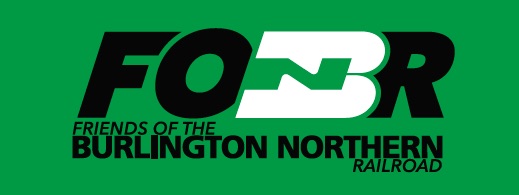High Visibility (Tiger Stripe) Locomotives
Starting in late 1984 BN debated making changes to the diagonal striped nose used on its engines since 1970. It came up with a design of the alternating black and orange nose stripes and cab face of orange. Because of the unique paint selection it acquired the Tiger Stripe nickname.
However, the first attempt to improve grade crossing visibility actually began in 1973 with the Chicago West Suburban Mass Transit District E-9’s. The Illinois Department of Transportation requested orange diagonal stripes on the face of each unit. The solution was to apply orange and white to the nose below the headlight.
In 1985 the Tiger Stripe test began on the SD40-2 BN 8002. The unit also became the first to have the number and logo switched. This has the BN logo and name moved to the long hood and unit number moved to the cab. After a period of time leased SD60’s BN 8300-8302 tested the paint scheme, and the 1985 order of GP50’s 3110-3162 was delivered in Tiger Stripe. Although the orange changed the appearance of units it was not considered aesthetic and economic and dropped after three years.
By 1989 the 8002 and GP50’s were repainted, the SD60’s were returned to GM and later repainted to the maroon-gray-silver lease scheme and in late 2000′ traded to the CSX. E-9’s worked the famed BN racetrack with fading orange until retirement in 1992.
Although not part of the 1980’s High Visibility study BN E units are included in this list.
|
GP50 |
|||||||||||||||||||||||||||||||||||||||||||||||||||||
|
|||||||||||||||||||||||||||||||||||||||||||||||||||||
|
SD40-2 |
|||||||||||||||||||||||||||||||||||||||||||||||||||||
|
|||||||||||||||||||||||||||||||||||||||||||||||||||||
|
SD60 |
|||||||||||||||||||||||||||||||||||||||||||||||||||||
|
|||||||||||||||||||||||||||||||||||||||||||||||||||||
|
E9 |
|||||||||||||||||||||||||||||||||||||||||||||||||||||
|

